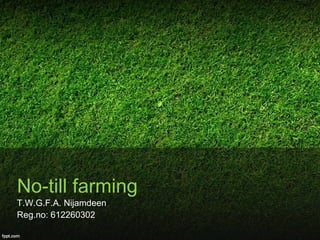
The no till farming
- 1. No-till farming T.W.G.F.A. Nijamdeen Reg.no: 612260302
- 2. Tillage methods • Conservation tillage -no tillage -mulch tillage -ridge tillage -strip tillage • Conventional tillage -mechanized tillage -traditional tillage
- 3. What is conservational tillage? • According to the Conservation Technology Information Center in West Lafayette, Indiana, USA, conservation tillage is defined as: “any tillage or planting system in which at least 30% of the soil surface is covered by plant residue after planting to reduce erosion by water” • No-till crop production systems leave the most residue and often prove to be the most profitable methods of crop production.
- 4. What is no-till farming? • no-tillage can be defined as a system of planting (seeding) crops into untilled soil by opening a narrow slot or trench only of sufficient width and depth to obtain proper seed coverage. No other soil tillage is done (Phillips and Young 1973).
- 5. Why no-till farming? • Prevent soil erosion They significantly reduce soil erosion, helping preserve the long-term productive capacity of the managed fields • Increase farm profit The practices can increase farm profits by reducing tillage costs without reducing crop productivity.
- 6. Why no-till farming is important than conventional farming? • Hydrological characteristics - water infiltration no till farming filter more water than of conventional farming. -moisture of the soil moisture is much conversed in no till farming
- 7. • Micro climate - soil temperature Soil temperature and diurnal fluctuations thereof are usually observed to be lower under no- till(Lal,1975) - airification of the soil This improves air quality by reducing dust and emissions from equipment operation. No-till also improves air quality by releasing less carbon from the soil into the atmosphere than traditional plowing practices.
- 8. No till farming: The technique • The basic principles of no till farming - planting of seeds in a narrow slit or hole - using chemicals to control weeds - application of inorganic fertilizers over the crop residue mulch
- 9. Pre-plant herbicide weed control -A good kill of weeds before seeding or planting is an essential pre-requisite to successful no-till farming. -In the no till system, preplant weed killing by the application of a total weed killer is more equivalent to the laborious tasks of the conventional farming. - commonly used herbicides: glyphosate,paraquat
- 10. Injection planting After a good preplant weed kill has been achieved, the seeds to be sown are injected planted though the mulch into the soil. Here the surface mulch should be left undisturbed after planting. No till planters, The stick punch planter rolling injection planter
- 11. Post-plant herbicide weed control In no-till farming ,selective,pre-or post emergence herbicides are applied soon after seeding and prior to crop emergence are exclusively used for post-plant weed control. They are designed to kill weed seeds as they germinate but are selectively non-toxic to crop seedlings
- 12. • Herbicide applicators C-D-A Applicator - V-L-V sprayer -
- 13. Mulching Mulch This differ from crop to crop. A thicker mulch will help smoother weeds, but also impede emergence of the crop being seeded. Stubble the stubble should be as short as possible, and if long, should be grazed or burned before herbicide application.
- 14. Advantages of no-till farming • Soil conservation The mulch helps in the development and maintenance of surface aggregates and ensures rapid infiltration of water. • Soil amelioration The no till system, with a residue mulch and cover crop, improves and restores soil conditions degraded by mechanized land clearing.
- 15. • Moisture conservation and water use erosion The decrease in water runoff and surface evaporation, and an increase in the available water holding and retention capacity of untilled soil makes more water available for crop use in no till system than in tilled soil. Source (Totis de Zeljcovich 1984).
- 16. • Soil temperature In no-till farming the residue of old crops left on the surface and within the soil helps to protect the soil from the sun .thus conserve the soil temperature.
- 17. • Root growth and development The total root mass in no tillage soil is generally more than with conventional ploughing. The lateral root spread is greater in no tillage than in ploughed soil.
- 18. • Soil biological activity • High earthworm activity contribute highly to the mixing of nutrients and organic matter in the soil and also they improve soil structure and porosity. • No-tillage soils support a greater number of beneficial insects and a higher microbial population .
- 19. • Nutrient status The no tilled soil has a high concentration of organic carbon, total nitrogen available prosperous and exchangeable calcium and potassium in the surface layer than ploughed soil. • Weed control The application of the mulch suppress the weed growth and this is much effective.
- 20. • Less work, more money By the elimination of ploughing,harrowng,and other operations ,the fuel is much saved in no till farming system. As well as the labour requirement is low and different types of farm machinery are no longer required with the no till farming.
- 21. Disadvantages of no till farming • Special machinery are needed. • Some conservation tillage practices are not successful in certain situations and soil types • Depending on site-specific circumstances and costs, additional herbicides may be applied to a field. • Crop damage from disease outbreak and nuisance insects can be higher where conservation tillage practices are used. • additional application of fertilizers like nitrogen may be necessary based on the condition of crop residue present.
- 22. So, No till farming is an easy and a successful way of farming which increase farm profit while reducing costs….
- 23. Thank you
